Disclosure: This post (probably) contains affiliate links. If you click on one, I may make a small commission. Of course, this will come at no extra cost to you and helps keep this site running.
If you don’t know what to expect when visiting Bulgaria, you’re not alone. I had no preconceived ideas about the country when I first went and my planning was honestly very limited. At that time, Bulgaria felt like it wasn’t on people’s radar. Visiting more recently, it still feels that way.
Yes, Bulgaria is fairly popular as a seaside destination in summer, but even that’s not on the same scale as its Mediterranean and Adriatic cousins. All this is to say that visiting Bulgaria was eye-opening, as I began to learn more about the history, culture, and people of this extraordinary country.
My return to Bulgaria may not have always gone as planned, but even then it was a joy to further explore this little corner of Europe. For those thinking of travelling to Bulgaria, here is my Bulgaria travel advice with what I think you need to know for your visit.
1. Look Past Bulgaria’s Coast
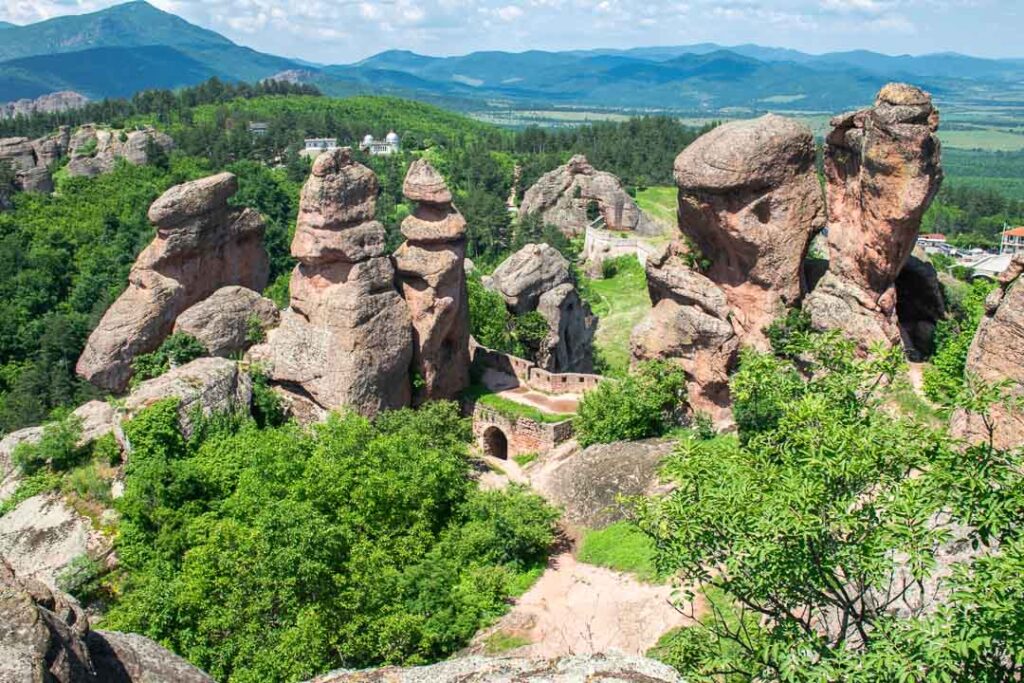
Since Bulgaria’s coast is where the country is most popular with tourists, let’s start there. If you’re seeking an affordable beach vacation, places like Sunny Beach and Sozopol are worth the trip. And the historic port towns on the Black Sea are also worth visiting on their own.
But it pains me that people don’t realise how many other fascinating places there are to visit on a vacation to Bulgaria. The capital Sofia is a good starting point, with its complex history and socialist relics. Look even just a little deeper and you quickly find other cities in Bulgaria to go to, from the immensely cool city of Plovdiv to the former royal capital of Veliko Tarnovo.
Bulgaria’s mountains cover much of the country’s interior and not only are they really fun to explore, they hide lots of great smaller destinations as well. Visiting the Monastery of Dryanovo and the unique Sand Pyramids of Melnik were two highlights of my first visit. Seeing the Rila Monastery and Belogradchik Fortress, two of the most famous Bulgarian attractions, on my return trip was just as memorable.
2. Bulgaria Visa Requirements for Entry
While Bulgaria is part of the European Union, it is not yet part of the Schengen Area that allows free movement between countries, something many EU countries currently benefit from.
This means that when entering Bulgaria you will go through passport control and visa requirements vary. For information on Bulgaria travel requirements, here is one place to start. At the time of writing, travellers from Australia, New Zealand, USA, Canada and most of Europe did not require visas for stays under 90 days.
Crossing the border from Turkey to Bulgaria, our train was stopped and border police came aboard. They collected passports, took them away and then returned them. Don’t be alarmed that people would take off with your passport without saying anything – it is fairly common practice in Eastern Europe and the Balkans.
3. Public Transport in Bulgaria

One of the biggest challenges of travelling in Bulgaria is getting around. The country’s mountains tend to get in the way a lot, especially since so many popular things to do in Bulgaria are found in or near them.
There are also drawbacks to public transport in Bulgaria. I’ve yet to travel by train in Bulgaria, aside from the overnight train from Istanbul, but do not hear good things about its reliability. The travellers I’ve talked to who used it encountered significant delays and were told by locals that they often don’t use it.
Travel by bus has always been my go-to in Bulgaria. An extensive bus network of various companies crisscrosses the country, but Sofia is certainly a major hub. I think the buses are good value, especially for how cheap tickets are, and mostly punctual.
One thing to keep in mind is that most major cities have multiple bus stations, so do check which stations you are departing from and arriving at. Information can be found online at Bgrazpisanie or Balkan Viator, but it always pays to check at the station in case of a rare error.
Once you’ve arrived, most cities and towns have local bus networks that are pretty straightforward to use. When I first went in 2016, buses in most cities still had ticket ladies who sold tickets onboard, often for only 1 lev. That’s certainly not the case now in Sofia. Their metro/bus system lets you just use your bank card, it’s that easy.
4. Best Time to Visit Bulgaria

Timing is everything when you visit pretty much any place in Europe and Bulgaria is no different. Go to Bulgaria in summer and you’re met with hot and humid weather, except for the Black Sea coast. Travel to Bulgaria in winter and the chances of snow are pretty high. Did I mention all of the mountains?
So when is the best time to visit Bulgaria? Well, it depends on why you’re going. If you want beach weather, June through August should give you that. Those just looking to visit Bulgaria’s cities benefit from more flexibility as the shoulder season should work just fine.
You’d think the hiking season would line up with beach weather, but actually most of June isn’t great for hiking as there still may be lots of snow in the mountains. Instead, try visiting between July and September when the mountain trails are clear. As for skiing in Bulgaria, January to March should offer the best conditions to hit the slopes in the mountains.
5. Local Customs to Know
Part of the fun of travel is learning local customs and quirks, but they can definitely lead to confusion at first. The big one for me in Bulgaria is that they nod for No and shake their head for Yes.
Non-verbal communication in a country where you don’t speak the language is super important. English is spoken a little in Bulgaria, mainly with younger people and it is growing. But there are still going to be times where you need to rely a lot on gestures and body language.
That means, simple gestures like nods and head shakes become even more critical. If you ask a bus driver “Bansko?” and they shake their head, I guarantee your first instinct will be to keep looking. I know I did. This will take some time to adjust to during your visit, but I found it always helps to rethink what answer you were given to ensure you understood it properly.
6. Language and Reading Bulgarian
The language of Bulgaria is – you guessed it – Bulgarian. The language is heavily Slavic, but with enough twists to distance it from most other Slavic languages, eg. Czech, Russian, Croatian. It’s not the easiest of languages for English speakers to swiftly pick up.
English is generally spoken in the tourist-heavy parts of the coast, particularly in Sunny Beach, but it’s far from guaranteed. Away from the coast, younger people are the ones more likely to know some English. As for second languages, Russian is definitely the most common across the country, with German probably next.
The other major hurdle for tourists in Bulgaria is that they use the Cyrillic Alphabet. While probably best known for its use in Russia, Cyrillic was actually developed in Bulgaria in the 9th century. That knowledge won’t help you read it any better, but Bulgarians are very proud of that fact.
When trying to read Cyrillic, I tend to sound it out one letter at a time like a little kid. It takes some getting used to, but it helps that the following letters are the same as they are in Latin: ‘A’, ‘E’, ‘K’, ‘M’, ‘O’, ‘T’. It’s also useful that the following translates easily: a Cyrillic ‘P’ is Latin ‘R’, ‘C’ is ‘S’, ‘H’ is ‘N’, ‘X’ is ‘H’. With that little language lesson, you now know the first 4 letters of ‘HOTEL’ in Cyrillic are “XOTE”. Good luck with the rest!
A few basic Bulgarian phrases to help you get by include Dobŭr den which means ‘Good Day’; Blagodarya for ‘Thank you’; Molya te for ‘Please’; and Da and Ne for ‘Yes’ and ‘No’.
7. Managing Your Money

Bulgaria is another Eastern European country where your Euro is not of much use. The national currency of Bulgaria is the Lev (BGN). Thankfully, the Lev seems to have a fixed rate against the Euro at 2 lev to 1 euro, making the mental currency conversion pretty easy.
For those out on the coast, you may not even need to do your own arithmetic as many signs and restaurants are also shown in Euros or Pounds.
But currency conversion shops are widely found around Bulgaria, especially in places like Sofia and the coast. They mainly exist to convert back and forward between Euros and Lev. While you always want to be wary of the rates you’re getting, my experience in Sofia was surprisingly good.
Now if you’re getting cash out of ATMs, a word of warning. Across the country, you’ll find Euronet ATMS – and I highly recommend not using them. While using my Wise card, I used this guide on ATM fees to avoid extra fees.
While having some cash in Bulgaria is useful, you can use your credit card in Bulgaria for a lot of things. Just make sure it’s a card that doesn’t slam you with currency conversion fees or bad exchange rates.
8. Is Bulgaria Safe to Visit?
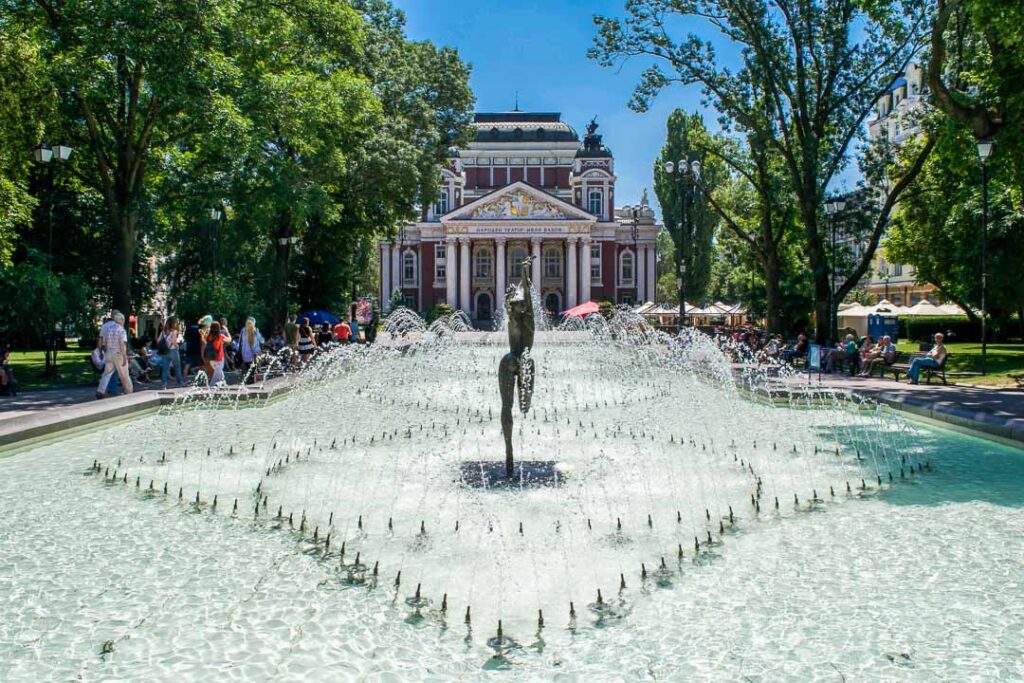
Yes, in my experience, Bulgaria is a safe place to visit. I’ve travelled across the country in public transport and even hitched rides with people and never encountered problems.
The closest I’ve come to feeling unsafe is when a crowd of loud football fans moved through the centre of Sofia after a game, and that can happen anywhere that loves the sport. That said, I don’t tend to go out drinking/partying or be out in the middle of the night, so my exposure to certain risks is lower.
Safety is always going to be a concern for travellers but it’s also deeply specific to individuals. I’m a white male travelling in a European country, so my experience and feeling of safety in Bulgaria doesn’t necessarily mean that all travellers will feel safe. This is true anywhere.
9. Fading Socialist Reminders

One aspect of tourism in Bulgaria that seems to appeal to many international tourists are the remnants of Bulgaria’s era under socialist rule. During the latter half of the 20th century, the country saw a lot of monuments and buildings created in the very Brutalist style that was in vogue under the socialist republic.
The fall of the People’s Republic of Bulgaria in 1990 still wasn’t that long ago so there are plenty of examples around Bulgaria you can still see today. Buzludzha Monument may be the most iconic of these landmarks, but the capital Sofia has more than a few monolithic, Soviet-looking sights of its own.
Visit the Socialist Art Museum in Sofia and you’ll see all sorts of sculptures and statues from this time period. There’s also the popular Communist walking tour, which lets you learn more about the history and how it affected the people of Bulgaria.
Veliko Tarnovo is another city with its fair share of relics from this period. Look no further than the brutalist Interhotel by the river or the incredibly unusual secular church atop Tsarevets Fortress. Further afield, I’ve heard of abandoned bunkers and the like for those who are into urban exploration.
10. So Much History to Explore
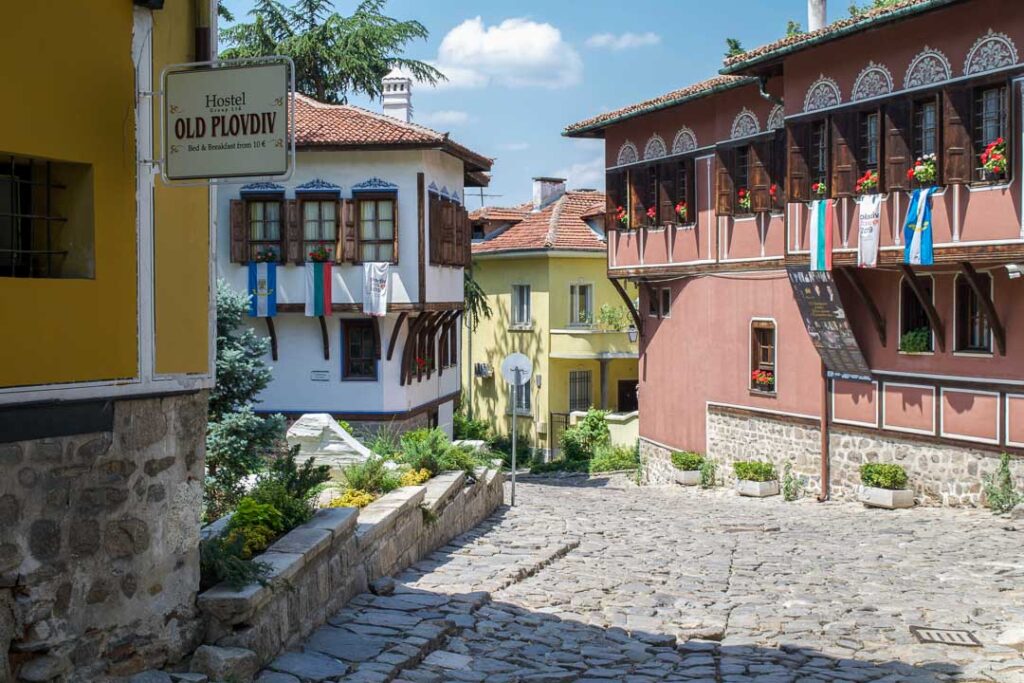
If you said you don’t know the history of Bulgaria, I don’t think anyone would hold it against you. And I’m not just talking about the country’s period of socialism. The good news is that there are plenty of places to visit in Bulgaria that show you the country’s history.
Did you know that you can find Roman ruins in Bulgaria? Plovdiv is home to several ancient Roman landmarks, including a large amphitheatre. Skip ahead and you have landmarks from the middle ages and Bulgaria’s imperial days, such as the Tsarevets fortress in Veliko Tarnovo. There are also plenty of Ottoman landmarks too, many of which are mosques.
Bulgaria’s historical side doesn’t just have to be informative though; it can also be extremely picturesque. From Plovdiv to Veliko Tarnovo and Nesebar, you’ll find gorgeous buildings in the style known as Bulgarian Revival. This architectural style comes from the Bulgarian National Revival movement of the 18th and 19th centuries which also led to Bulgaria regaining autonomy from the Ottoman Empire in 1878.
11. Hiking in Bulgaria

One of my favourite things to do in Bulgaria has been hiking in the mountains there. Now, Bulgaria isn’t one of Europe’s classic hiking destinations, but you’re not going to be disappointed with it if you go.
Most of my hiking in Bulgaria has been around the Rila and Pirin Mountains. But these mountains in the country’s southwest are just two of the main mountain ranges in Bulgaria. You also have the reasonably remote Rhodope Mountains to their east, and the more accessible and extensive Balkan Mountains through the heart of Bulgaria.
Even though it was mostly cold, wet, and foggy for my hiking trip to Bulgaria, I still had a great time. Both when I was meandering around the Pirin Mountains and heading up to the Boyana Waterfall outside Sofia, I loved having the country’s pristine nature practically to myself. I am glad that the weather held up for my Seven Rila Lakes hike though, as the views on that hike are next level.
You have plenty of options for hiking here, both in terms of location, but also whether you want to do a longer hiking trip or just day hikes. For me, I’m still waiting to tackle Musala, the highest mountain peak in Bulgaria.
12. Bulgarian Foods and Drinks
Looking back, I don’t think I’ve been all that adventurous with my food habits when visiting Bulgaria. That’s probably because it’s never hard to find typical Bulgarian restaurants and common Balkan dishes such as kebapche and kufte.
But there are some Bulgarian staples I’ve tried during my visits. Despite their overwhelming volumes of sirene cheese, I’ve had my share of shopska salad and banitsa (pastry filled with cheese). And one of my go-to orders is kavarma, a kind of meat and vegetables served in a clay vessel.
I will admit though I’ve avoided Bulgaria’s famous yoghurt, ayran, simply because I’m lactose intolerant. But if you’re not, don’t skip this popular drink that you can find *everywhere*. Drinks I haven’t shied away from have been Bulgaria’s various beers, Shumensko, Kamenitza, and Pirinsko to name a few.
One thing I only learned about Bulgaria by visiting is that the country is quite a major wine producer. Mavrud, a red wine grape, is probably the best known variety from Bulgaria and is worth trying if you see it on a menu when in Bulgaria. Visit Melnik and you can also explore the town’s fruit wines, which I quite enjoyed.
13. Is Bulgaria Cheap to Visit?
Yes, Bulgaria is an affordable destination to visit and I’d say it’s one of the cheapest countries to travel in across Europe. The Balkans is a generally affordable region for international travellers to visit and I think Bulgaria is somewhere in the middle relative to the rest of the region.
The most expensive places to visit in Bulgaria are going to be the Black Sea Coast and then Sofia. Prices in these places weren’t that high during my first visit to Bulgaria, but accommodation in Sofia was definitely more expensive in 2023. Looking at prices for the coast as well, they also seem to have risen considerably.
Expenses in Bulgaria for things like food, attractions, and public transport are quite reasonable in my opinion. Filling dinners at basic restaurants for one person can comfortably cost 10-15€, while coffee typically only costs 1-2€. Entry to museums and attractions in Sofia typically cost around 5€. Public transport around Sofia for a day cost me less than 3€. A 3-hour bus ride from Sofia to Bansko costs 10€.
14. Is Bulgaria Friendly to Tourists?
As is so often the case with questions like this, it’s hard to say that everyone in Bulgaria is going to be completely friendly to you as a tourist. So many things affect this, from language barriers to perceptions of race/gender/orientation.
Across my Bulgaria travel experiences, I’ve met plenty of welcoming people in the tourism sector (guides, hotel staff, etc.). Then there have been friendly locals like the man that offered to provide suggestions of where to go when I hiked up to Boyana waterfall.
Of course, I’ve also experienced people that have been standoff-ish. And that’s true of most countries I’ve been to in Europe, especially places that are less accustomed to foreign tourists. But in Bulgaria at least, I can’t recall anyone being rude or offensive.
I think if your expectation of “friendliness” is big broad smiles, people greeting you on the street, and endless enthusiasm to help you, you’re going to be disappointed. Basically, don’t expect “American hospitality”.
15. Bulgarian Martenitsa
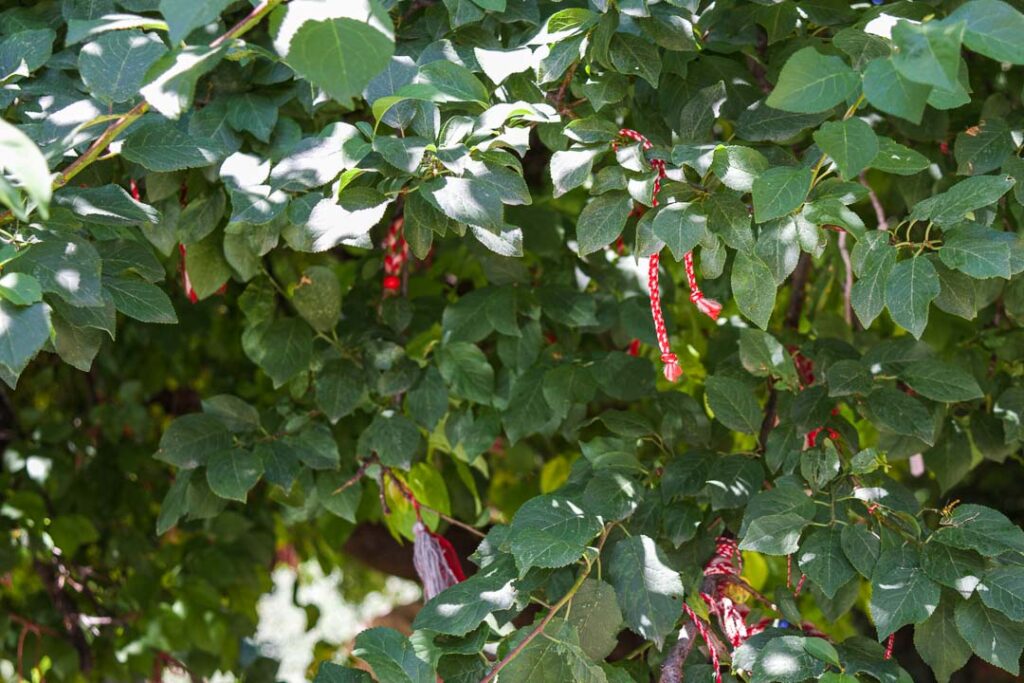 One of the smallest cultural habits I came across time and time again visiting Bulgaria was the Martenitsa bracelet. As it was told to me (it differs slightly across the country), this long held Bulgarian tradition involves people giving loved ones bracelets of red and white yarn at the start of the month of March.
One of the smallest cultural habits I came across time and time again visiting Bulgaria was the Martenitsa bracelet. As it was told to me (it differs slightly across the country), this long held Bulgarian tradition involves people giving loved ones bracelets of red and white yarn at the start of the month of March.
The bracelet’s colours represent vitality and purity, representing a wish for the wearer’s health in the coming year. Locals wear the bracelets until the first sighting of spring blossom, swallows or storks.
At this point, people take the bracelets off and tie them to trees, passing the wishes of vitality onto the tree. During my visit in July, you were still able to find many trees decorated with Martenitsa.
Resources for Visiting Bulgaria
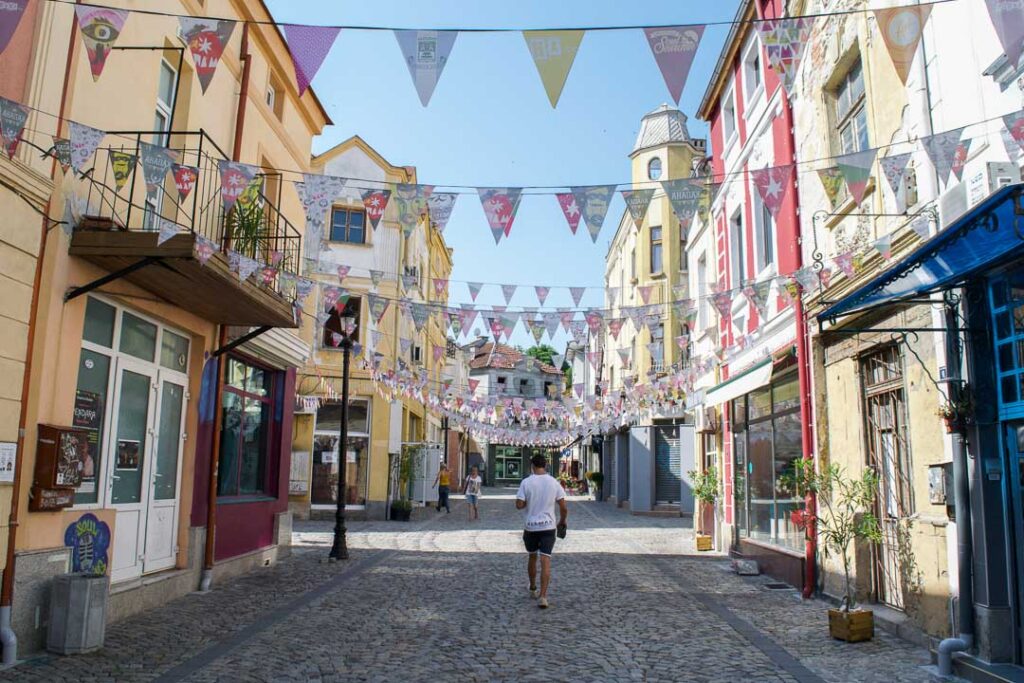
- Getting There: To find the cheapest and most convenient flights to Bulgaria make sure to check Kayak.
- Accommodation: Here you can find hotels, apartments and guesthouses for across Bulgaria, plus don’t forget Airbnb.
- Tours: There are countless day trips, cruises, and sightseeing tours available in Bulgaria.
- Car Hire: If you want to travel more independently, consider renting a car to drive yourself about.
- Guide Books: Lastly, take a Lonely Planet Guide book if want a physical guide.
What other things would you like to know before visiting Bulgaria? Have you visited Bulgaria and have other insights to share? Please share them in the comments below.
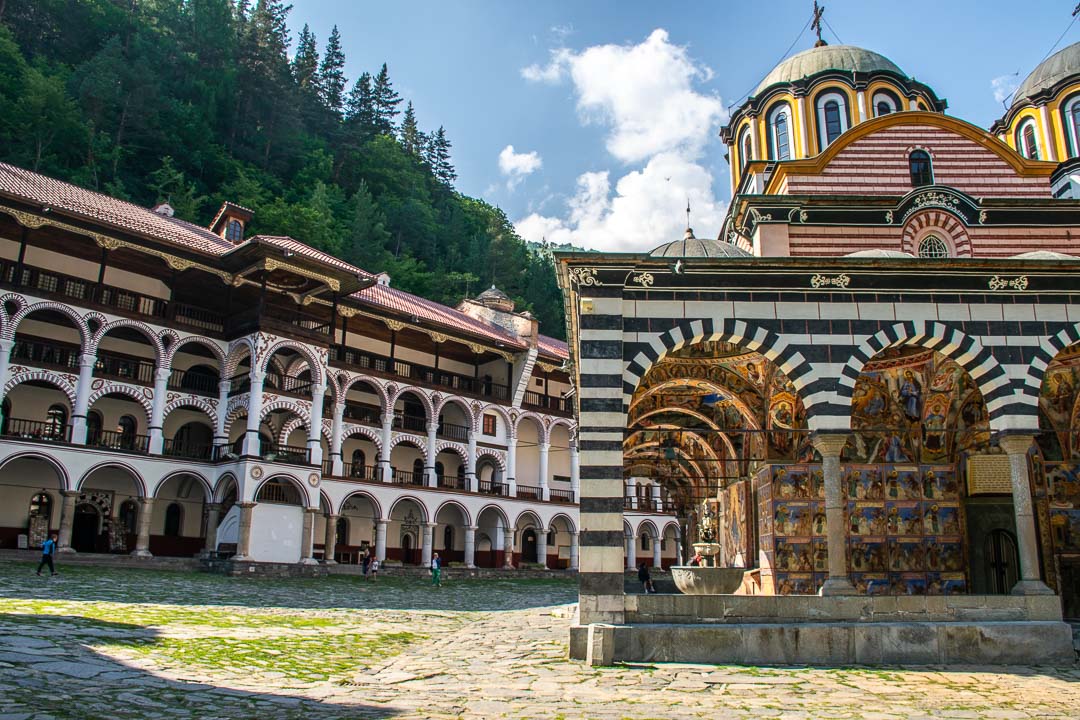
23 comments
This was definitely helpful! We had our big honeymoon planned for Italy at the moment but at 80% sure that we are going to cancel it and do a huge 2 week road trip through the Balkans hitting up Montenegro, Macedonia, Bulgaria and Romania mostly. Keep an eye out because I might be contacting you for recommendations, if you don’t mind! 🙂 I’ve already used your blog for a lot of info!
Glad to hear it Lorelei! I’m such a big fan of the Balkans so more than happy to help if you have questions or need recommendations. Have a great time!
Thank you! I’m just getting started on research so I’ll hit you up if/when I have questions. 🙂
Don’t miss out on Albania if you are doing a Balkan road trip. IMO the most interesting country to visit in the Balkans.
Don’t worry, we WILL visit one day, most likely as it’s own trip! I’m dying to visit!
great tips! I might use them one day:) #wanderfulwednesday
That nodding/shaking your head means the opposite from what we understand of it is definitely new to me! I’ll have to keep that in mind if I ever get to visit Bulgaria. I certainly don’t understand or speak Russian, let alone Bulgarian… 😉
Martenitsa sounds like a lovely custom. Enjoyed reading about it.
Unfortunately in Norway Bulgaria is synonym with party people, so I’ve never wanted to go. Know I should see beyond 🙂
These are great tips. The only thing I really know about Bulgaria is where to locate it on a map. I eventually would like to visit but it’s not high on my list. #wkendtravelinspiration
Haha that’s ok Allison, that’s probably more than many people can. I totally understand the perils of having a long list of places you want to visit. I hope you reach that far down the list one day 🙂
Great tidbits of information! I’ll definitely remember that nodding means no and that shaking your head is yes…wowzers! Bulgaria is on my radar since I’m living in Moscow now. 😀
The former eastern block countries fascinate me. I hope to visit Bulgaria and Romania someday.
We did a great road trip in Bulgaria, and although the roads are not the best, we had a fabulous time. We did see the bracelets on many trees in the church yards. Good article.
I know a few people from Bulgaria and friends who visited really enjoyed it for the culture and low prices compared with other parts of europe. nice reminder of what it’s worth visiting the less touristy parts of the world. #wkendtravelinspiration
Like you, I have no preconceived ideas about Bulgaria. It was good to learn more from you about this country. I am nodding my head, or am I shaking it 🙂
One of the things that intrigues me most in Bulgaria and other former Soviet Bloc countries is the Communist remnants. Particularly architecture and public works. Amazing in their own way, and still historically important. Also, that Bulgarian Revival architecture is great! Looks like another country we’d enjoy just wandering through and admiring! As always, great post!
Stay away from the coast. Party time is not educational.
I think you can still enjoy the coast if you don’t like partying. I know I did.
Bulgaria has become really popular for skiing, if you are a fan of winter sports, Pomporovo or Bansko in the winter will rock your expectations!
This was a very interesting and informative article but let me tell you this . I am Bulgarian myself . I was born and raised in Varna and then later in my life moved to Canada. There is a lot of misinformation floating out there such as the ” shake your head for NO and nod for YES” Simply not true unless they do that in some small high mountain village somewhere there it is absolutely NOT TRUE the rest of the country. Anyhow useful article never the less. Enjoy and happy travels everyone.
Thanks for commenting Ivo. That’s interesting to hear, perhaps it’s a regional thing. I definitely experienced it first hand in the west and know other people who experienced it as well
Visiting Bulgaria in the Winter can be really a great journey. I can say Borovets is one of the most popular destinations for this.